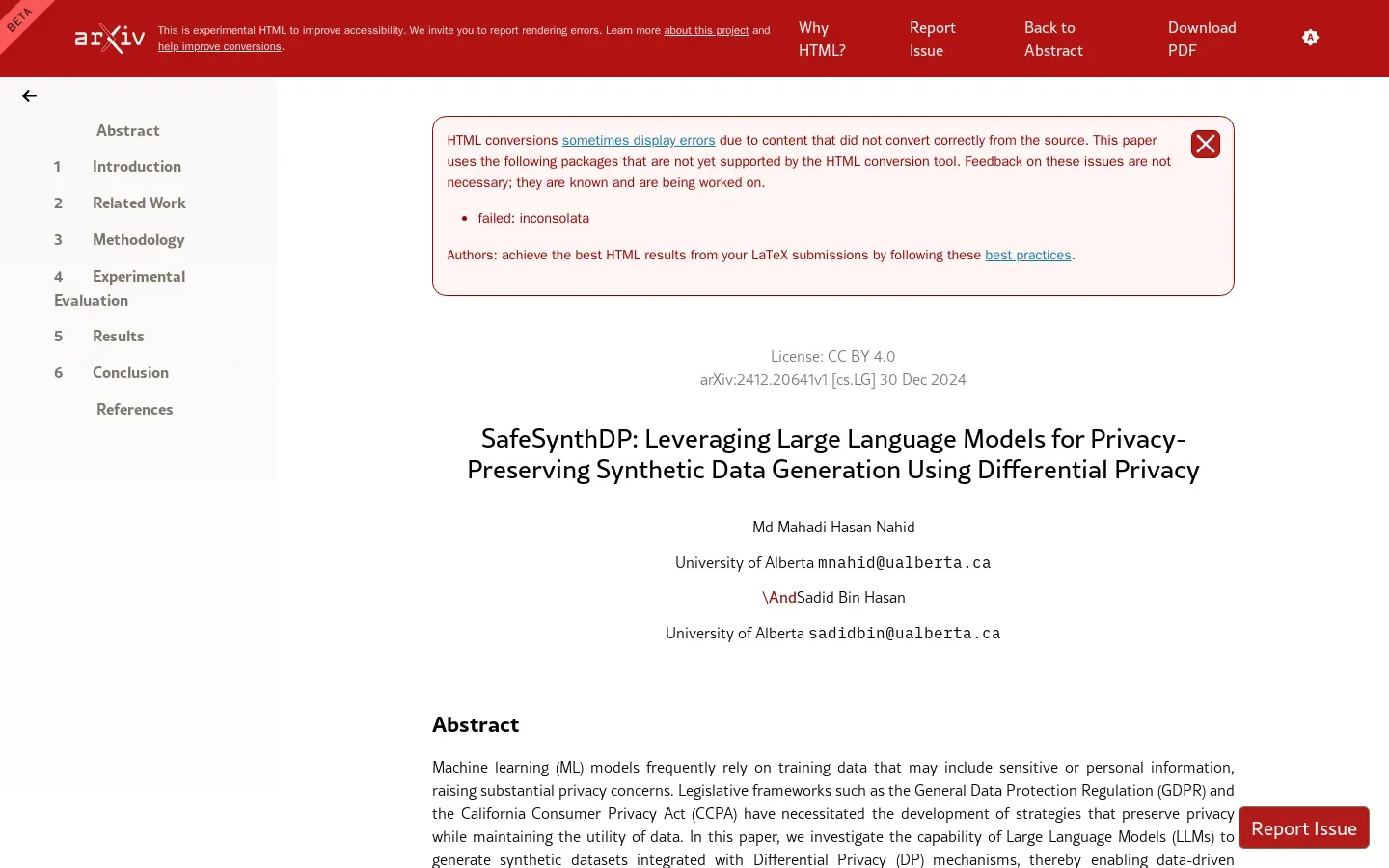
Advancements in Privacy-Preserving Synthetic Data Generation
/ 4 min read
Quick take - Recent research has made significant strides in privacy-preserving synthetic data generation by integrating Large Language Models and Differential Privacy mechanisms, aiming to create useful datasets for machine learning while ensuring compliance with privacy regulations.
Fast Facts
-
Integration of Privacy Mechanisms: The research combines Differential Privacy (DP) with Large Language Models (LLMs) to generate synthetic data that protects individual privacy while maintaining utility for machine learning applications.
-
Balancing Act: A key finding emphasizes the challenge of balancing data utility and privacy, highlighting the risks of information leakage and the necessity for robust privacy measures.
-
Generalizability and Applications: The developed approaches are applicable across various sectors, including healthcare, finance, education, and urban planning, enhancing data privacy in diverse contexts.
-
Innovative Techniques: The study employs techniques like Laplace and Gaussian noise injection and In-Context Learning (ICL) to improve the quality and privacy of synthetic data.
-
Future Implications: The advancements in privacy-preserving synthetic data generation are expected to significantly influence secure data practices and compliance with privacy regulations in multiple industries.
Advancements in Privacy-Preserving Synthetic Data Generation Using Large Language Models
Recent research has unveiled significant advancements in synthetic data generation, focusing on privacy preservation through the integration of Large Language Models (LLMs) and Differential Privacy (DP) mechanisms. This innovative approach aims to create synthetic datasets that can be utilized for various machine learning applications while ensuring compliance with privacy regulations. The findings hold substantial implications for enhancing data privacy, mitigating cybersecurity risks, and facilitating secure machine learning practices across multiple sectors.
Integration of Differential Privacy with Synthetic Data Generation
The study primarily examined how Differential Privacy can be effectively integrated into synthetic data generation processes to safeguard individual privacy. By incorporating DP, researchers aim to protect sensitive information while still allowing for the creation of useful synthetic datasets. This integration is crucial as it addresses the growing concerns around data privacy and regulatory compliance.
Leveraging Large Language Models
Large Language Models were utilized in the study to synthesize data that maintains utility without compromising privacy. LLMs have shown promise in generating high-quality synthetic data that retains contextual relevance, making them a valuable tool in this domain. Their ability to produce coherent and contextually appropriate data is pivotal in ensuring that the synthetic datasets serve their intended purposes effectively.
Evaluating Data Utility and Privacy Trade-offs
A critical analysis was conducted to evaluate the balance between data utility and privacy. The study assessed how well synthetic data serves its intended purpose without exposing sensitive information. This evaluation is essential, as achieving an optimal balance between these two aspects is a significant challenge in synthetic data generation.
Performance Assessment Using Machine Learning Models
Machine learning models were employed to assess the performance of the generated synthetic data in practical applications. This step was crucial in determining the effectiveness of the synthetic datasets in real-world scenarios, providing insights into their potential utility across various sectors.
Key Findings and Implications
Balancing Privacy and Data Utility
The research highlighted the challenge of achieving a balance between protecting user privacy and ensuring the utility of synthetic data for machine learning tasks. This balance is critical for the practical adoption of synthetic data in various applications.
Risk of Information Leakage
The study underscored potential risks associated with information leakage, emphasizing the need for robust privacy mechanisms. Ensuring that sensitive information is not inadvertently disclosed is a primary concern in this field.
Generalizability of Findings
Findings demonstrated that the developed approaches could be generalized across various use cases, signaling broader applicability beyond the initial research scope. This generalizability suggests potential for widespread adoption across different sectors.
Adoption in Security Applications
The research proposed that synthetic data could be adopted in security applications, enhancing defenses against cybersecurity threats. By using synthetic datasets, organizations can improve their security measures without compromising sensitive information.
Strengths and Limitations
The strengths of this research lie in its innovative integration of LLMs and DP, offering a novel framework for synthetic data generation that addresses privacy concerns. However, limitations include the need for further exploration into specific applications and potential challenges of implementing these methodologies in real-world scenarios.
Recommended Tools and Frameworks
Several key tools and frameworks play pivotal roles in generating privacy-preserving synthetic data:
- Large Language Models (LLMs): Utilized for generating high-quality synthetic data.
- Differential Privacy (DP): Ensures individual data points’ privacy.
- Laplace and Gaussian Noise Injection: Techniques to enhance privacy by adding controlled noise.
- In-Context Learning (ICL): Improves quality and relevance of synthetic data within LLMs.
Future Directions and Applications
The implications of this research extend to various sectors:
- Healthcare Data Sharing: Enhancing protection of sensitive health information while enabling research.
- Financial Services: Improving fraud detection systems’ security through synthetic data.
- Education: Facilitating personalized learning experiences while preserving student privacy.
- Smart Cities: Enabling data-driven urban planning decisions while safeguarding citizen data.
As industries increasingly prioritize data privacy, these advancements are poised to shape secure data practices’ future across multiple domains. The ongoing exploration into specific applications will further define how these methodologies can be implemented effectively, ensuring both compliance with regulations and practical utility.



